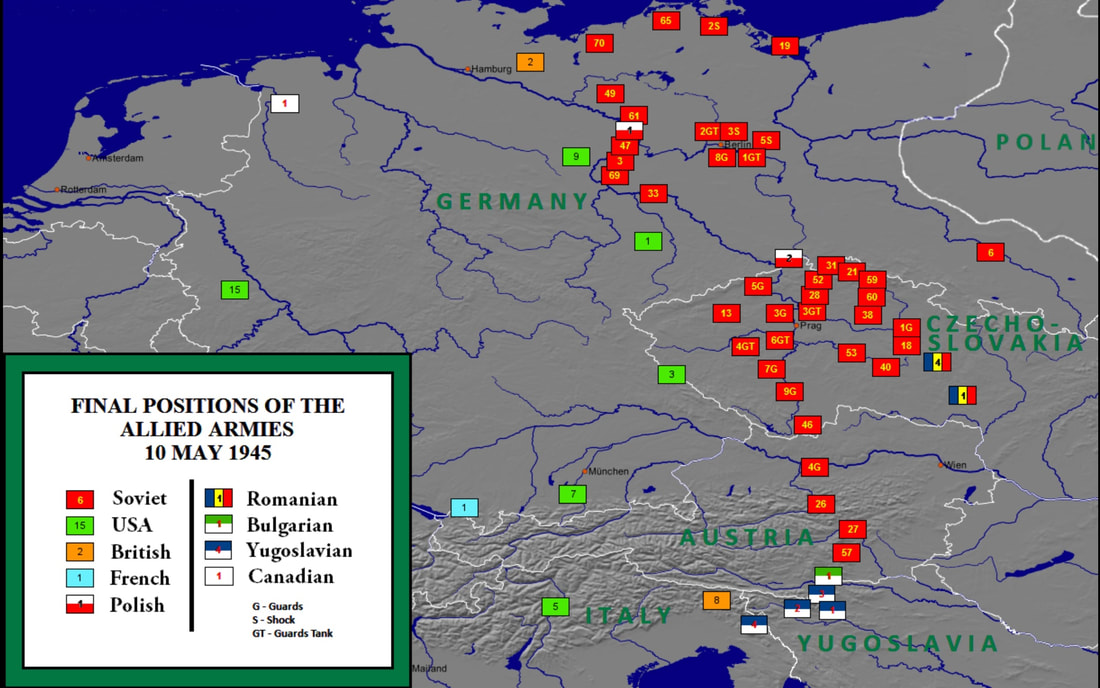bigpigeon.us webpage WWII Germany > The ETO > Central Europe > Germany Surrenders, © 2023 by Robert A. Christiansen, updated by RAC 9 Nov 2022.
Webpage being modified. Early content will be moved to new webpages.
Webpage being modified. Early content will be moved to new webpages.
In the winter and spring of 1945, Soviet forces advancing through Poland overran the part of Germany north of Czechoslovakia, including the German capital of Berlin, while the Western Allies crossed the Rhine in March and then fought east through the remainder of Germany.
Here are some memorable dates, including Soviet operations, for this, the last phase of World War II in Europe:
Here are some memorable dates, including Soviet operations, for this, the last phase of World War II in Europe:
- 1 Apr 1945 - Ruhr, Germany's largest industrial area, surrounded.
- 12 Apr 1945 - Anticipating future Holocaust-deniers, General Eisenhower visits the liberated concentration camp at Ohrdruf near Buchenwald.
- 12 Apr 1945 - President Roosevelt dies suddenly in Warm Springs, Georgia.
- 16 Apr 1945 - Russians begin Battle of Berlin.
- 25 Apr 1945 - American and Russian troops meet at Torgau on the Elbe River northeast of Leipzig.
- 30 Apr 1945 - Adolf Hitler suicides in his Berlin bunker.
- 2 May 1945 - Berlin falls after massive, lengthy, and bloody Russian attack.
- 7 May 1945 - Germany surrenders at Reims, France.
- 8 May 1945 - V-E (Victory in Europe) Day, European hostilities cease.
Occupying the Ruhr - March-April 1945
|
Elements of the US First Army began crossing the Rhine with the siezure of the bridge at Remagen on March 7. The Ninth Army crossed with Montgomery's 21st Army Group in Operation Plunder near Wesel beginning on March 23.
Once across the Rhine, the Ninth Army was returned from British control to become part of Bradley's 12th Army Group. The Ninth and the First Armies then coordinated their efforts to seal off and then capture the Ruhr, on the east side of the Rhine and Germany's largest industrial area. Most German forces in the Ruhr Pocket surrendered on April 16. Organized resistance ended on April 18. By then, much of the Ninth and First Armies had advanced well to the east. |
The Western Allies Drive Across Central Germany - April-May 1945
|
By April 19, the Ninth and First Armies had reached the west bank of the Elbe River, with Russian forces already on the east bank.
During the last several weeks of the war, Patton's Third Army, to the south of the First Army, occupied most of southeastern Germany, penetrating into small portions of Czechoslovakia and Austria. The Seventh Army and the French 1st Army focused on occupying southwestern Germany, with elements of the Seventh Army making contact with the US Fifth Army at Brenner Pass on the Austrian - Italian border. The Canadian First Army continued liberating the Netherlands. Much to the chagrin of General Montgomery, the British Second Army's primary responsibility was flank protection as the US Ninth Army raced across the north German plain. |
Germany Surrenders - 7 May 1945
|
Germany forces in Italy had already surrendered effective May 2.
In the final weeks of the war, some high-ranking German figures attempted to negotiate a conditional surrender to the Western Allies. These attempts were rebuffed. The unconditional German surrender to the Allies occurred on May 7, 1945 at General Eisenhower's ETO headquarters in Reims, France, in a building now housing a museum. General Jodl, who represented Germany, was one of the Nazi leaders later executed in 1946. Although the surrender document was signed early on 7 May 7, hostilities were to cease late on 8 May. I know of two events where smaller German military units acted independently and with compassion before the German government's surrender.
How the world celebrated on May 8! |
The Allied Armies at the End of the War with Germany
|
The accompanying map shows the position of the Allied armies just after hostilities ended. Some commentary:
|
After the Surrender
|
Germany was divided into four occupation zones, with Berlin in the middle of the Russian zone.
|
Sources for Big Pigeon's The ETO > Central Europe > Germany Surrenders webpage:
- The page header photo, Soviet Flag on the Reichstag, is courtesy of rarehistoricalphotos.com. The Battle of Berlin raged from 16 Apr to 2 May. 80,000 Russian troops died; German losses, including civilians, were higher. The first Soviet flag was raised at night on 30 Apr and removed by German soldiers. This photo, taken on 2 May by Yevgeny Khaldei, was subject to a bit of editing, including adding smoke.
- The Enveloping the Ruhr map is courtesy of historynet.com.
- The Final Phase of the Central European Campaign map is courtesy of the United States Military Academy History Department.
- The photo of General Jodl at the surrender table is courtesy of ww2db.com.
- The V-E Day Buckingham Palace photo is courtesy of the Imperial War Museum in London.
- I found The Allied Armies at Wars End map at https://en.wikipedia.org/wiki/Line_of_contact#/media/File:Allied_army_positions_on_10_May_1945.png.
- The Germany after WW II map is courtesy of http://germanhistorydocs.ghi-dc.org.









